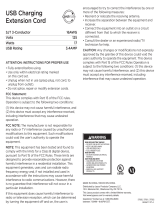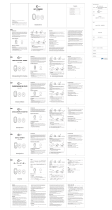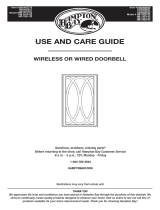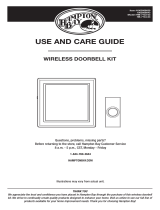
19298
19299
19300
Version 07
6/12/2017
work, see TROUBLESHOOTING.
3. Hold the back plate of the push button
in the selected location with the arrow
on the back of the back plate pointing
up.
4. Using the 1/16" drill bit, drill a hole
through the back plate of the push
button (See Figure 4 — Mounting hole
locations) and into the surface of the
selected location.
5. Secure with the two screws provided.
6. Press front housing onto back cover.
7. Test operation. If chime does not work,
see TROUBLESHOOTING.
Temporary Push button (transmitter) mounting instructions
1. Clean the mounting location for the push button with a mixture of 50% water and 50%
isopropyl alcohol.
2. Remove protective backing from one side of the adhesive pad and attach it to the back
plate of the push button.
3. Remove protective backing from the other side of the adhesive pad and press the back
plate to the cleaned mounting location and hold in place for a few seconds to allow for a
secure bond.
Chime (receiver) mounting instructions
Plug the chime into the top receptacle of the outlet (See Figure 5).
Extra chime receivers and push buttons available at www.byjasco.com.
Troubleshooting
If the chime does not work:
1. Make sure push button switch is pressed down and held for at least 1 second.
2. Verify battery installation is correct, noting polarity.
3. Try a fresh battery in push button.
4. Make sure chime is no further than 150 feet away from push button.
5. Ensure push button is not mounted on metal, near metal studs, or near the floor.
6. Try a new location for the chime.
7. If the chime and push button(s) do not operate, repeat the electronic pairing process of
the push button(s) to the chime in steps A-F below.
A. To clear settings: Press and hold the pairing button
on the bottom of the chime while plugging the chime
into the outlet.
B. Once chime is plugged in, release the pairing button.
C. Press and hold the pairing button again. You will hear
the “Ding Dong” melody twice, and then the double
beep to alert you the chime is ready to pair with the
push button. Release the pairing button.
D. Press and release the push button (See Figure 3). You
will hear one beep letting you know the chime accepted the signal.
E. Wait 10 seconds and you will hear the double beep again to alert you the chime is now
paired with the push button.
F. Press the push button to test.
Functional range may be adversely affected by one or more of the following factors:
weather, radio frequency interference, low transmitter battery, and obstructions between
the transmitter and receiver.
This device complies with Part 15 of the FCC rules. Operation is subject to the following
two conditions:
(1) this device may not cause harmful interference, and (2) this device must accept any
interference received, including interference that may cause undesired operation.
FCC NOTE: The manufacturer is not responsible for any radio or TV interference caused by
unauthorized modifications to this equipment. Such modifications could void the user’s
authority to operate the equipment.
NOTE: This equipment has been tested and found to comply with the limits for a Class B
digital device, pursuant to Part 15 of the FCC Rules. These limits are designed to provide
reasonable protection against harmful interference in a residential installation. This
equipment generates, uses and can radiate radio frequency energy and, if not installed
and used in accordance with the instructions may cause harmful interference to radio
communications. However, there is no guarantee that interference will not occur in a
particular installation. If this equipment does cause harmful interference to radio or
television reception, which can be determined by turning the equipment off and on, the user
is encouraged to try to correct the interference by one or more of the following measures:
• Reorient or relocate the receiving antenna.
• Increase the separation between the equipment and receiver.
• Connect the equipment into an outlet on a circuit different from that to which the
receiver is connected.
• Consult the dealer or an experienced radio/TV technician for help.
Wireless Door Chime
Installation instructions
Required tools: Small flat blade screwdriver, #2 Phillips screwdriver, and 1/16" drill bit
(not included)
The wireless door chime kit has two components:
Installing battery in push button (transmitter)
1. Remove the front cover of the push button housing by pushing a flat blade screwdriver
into the slot at the bottom of the push button housing (See Figure 1).
2. Install the CR2032 battery (included) with the positive (+) side up.
3. Keep the front cover off the push button until melody selection is complete.
NOTE: The chime and push button(s) have been electronically paired during production.
Once the battery is installed in the push button and chime is plugged in, press the push
button(s) to ensure that the push button(s) cause the chime to operate.
IF CHIME DOES NOT SOUND, SEE TROUBLESHOOTING.
Melody Selection Setting (your chime will have either 2 or 8 melodies)
Select the melody by pushing the Melody selection button located inside the push button
housing (See Figure 1). Press and release the melody selection button until you hear the
desired melody. Table 1 and Table 2 shows the order the melodies will be heard.
The last melody played will be your selected chime melody.
Volume Adjustment
There are four volume settings on this chime.
1. To adjust the volume, press and release the pairing button on the chime to play
the melody.
2. While melody is playing, press and release the volume button on the chime
to select the desired sound level.
Push button (transmitter) mounting instructions
NOTE: Avoid mounting on metal surfaces, as it may result in
a reduced range of transmission. Do not mount in an area
exposed to direct rain. Push buttons are typically mounted
at the same height as the door knob or handle (between 36"
and 44" above the floor).
Permanent push button (transmitter)
mounting instructions
1
. Remove the front cover of the push button
(See Figure 1).
2. Before mounting, choose a mounting location that is no
further than 150 feet from the chime unit location. Place
the push button where you would like to mount and test
with the chime as close to its final location as possible. If
it works, continue with mounting the button. If it does not
Chime (Receiver) Figure 2
VolumePairing
Push
button
Mounting
hole
locations
Battery
compartment
Melody
selection
button
Push
button
Push flat blade screwdriver into
the slot to open the cover
Figure 3
Plug the chim
e
into the to
p
re
ceptacle of
the outlet
Figure 5
Table 2 - 8 Melody Chime
1 Dingdong
2 Westminster
3 Knocks (3 times)
4 Fanfare
5 Mozart
6 Good Vibes
7 Patriotic
8 Tango
Table 1 - 2 Melody Chime
1 Dingdong
2 Westminster
Push Button (Transmitter) Figure 1
Push
button
Mounting
hole
locations
Battery
compartment
Melody
selection
button
Push
button
Push flat blade screwdriver into
the slot to open the cover
Mounting
hole
locations
Battery
compartment
Melody
selection
button
Push
button
Figure 4
MADE IN CHINA
GE is a trademark of General Electric Company and is under
license by Jasco Products Company LLC, 10 E. Memorial Rd.,
Oklahoma City, OK 73114.
This Jasco product comes with a 1-year warranty.
Visit www.byjasco.com for warranty details.
Questions? Contact us at 1-800-654-8483 between
7:00AM—8:00PM CST.

4. Con el 1/16 broca “, taladre un orificio a
través de la placa trasera del botón (vea
la figura 4, ubicaciones de los orificios
de montaje) y en la superficie de la
ubicación seleccionada.
5. Atornille con los dos tornillos
proporcionados.
6. Pulse la cubierta frontal para encajarla
en la tapa trasera.
7. Pruebe si funciona. Si el timbre
no funciona, consulte la sección
RESOLUCIÓN DE PROBLEMAS.
Temporal Presione el botón (transmisor)
Instrucciones de montaje
1. Limpie la superficie de montaje del botón pulsador con una mezcla 50% de agua y 50%
de alcohol isopropílico.
2. Retire la capa protectora de un lado de la almohadilla adhesiva y péguela a la placa
posterior del botón pulsador.
3. Retire la capa protectora del otro lado de la almohadilla adhesiva, presione la placa
posterior contra la superficie de montaje limpia y sujétela en el lugar por unos segundos
para garantizar que se fije bien.
Instrucciones de montaje de la campana (receptor)
Conecte el timbre en el receptáculo superior de la salida (ver figura 5).
Receptores de timbre adicionales y pulsadores disponibles
en www.byjasco.com.
Resolución de problemas
Si el timbre no funciona:
1. Asegúrese de que el botón pulsador esté presionado y manténgalo presionado por lo
menos durante 1 segundo.
2. Verifique la correcta instalación de la pila, teniendo en cuenta la polaridad.
3. Pruebe una pila nueva en el botón pulsador.
4. Asegúrese de que el timbre no se encuentre a una distancia mayor de 150 pies del
botón pulsador.
5. Asegúrese de que el botón pulsador no esté instalado sobre metal, cerca de montantes
de metal o cerca del piso.
6. Pruebe colocar el timbre en otro lugar.
7. Si el timbre y los botones pulsadores no funcionan, repita el proceso de vinculación
electrónica de los botones pulsadores con el timbre detallado a continuación en los
pasos del A al F.
A. Para borrar la configuración: Pulse y no suelte el botón sincronizador, ubicado en la
parte inferior del timbre, mientras enchufa el timbre al tomacorriente.
B. Tras conectar el timbre, suelte el botón sincronizador.
C. Pulse y sostenga el botón sincronizador nuevamente. Oirá dos veces la melodía “Din
Don”, y luego un doble aviso sonoro indicando que el timbre ya se puede sincronizar con
el botón pulsador. Suelte el botón sincronizador.
D. Oprima y suelte el botón pulsador (Ver Figura 3).
Oirá un aviso sonoro indicando que el timbre aceptó
la señal.
E. Aguarde 10 segundos hasta que escuche otra vez
el doble aviso sonoro indicando que el timbre ya se
sincronizó con el botón pulsador.
F. Oprima el botón pulsador para probar que funciona.
El rango de funcionamiento podría verse afectado por
uno o más de los siguientes factores: clima, interferencia
de frecuencia radial, pila baja del transmisor y bloqueos
entre el transmisor y el receptor.
Este dispositivo cumple con la Parte 15 de la normativa de la FCC. El funcionamiento está
sujeto a las siguientes dos condiciones:
(1) este dispositivo no debe provocar interferencia perjudicial, y (2) este dispositivo debe
aceptar toda interferencia que reciba, incluso la que pudiera causar un funcionamiento
no deseado.
NOTA DE LA FCC: El fabricante no se hace responsable de ninguna interferencia de radio
o TV ocasionada por modificaciones no autorizadas efectuadas a este equipo. Dichas
modificaciones podrían anular la autoridad del usuario para utilizar el equipo.
NOTA: este equipo ha sido probado y cumple con los límites para aparatos digitales
de Clase B, de conformidad con la Parte 15 de la normativa de la FCC. Estos límites
están diseñados para proveer protección razonable contra interferencias perjudiciales
en una instalación residencial. Este equipo genera, usa y puede irradiar energía de
radiofrecuencias y, si no se instala y usa según las instrucciones, puede provocar
interferencia perjudicial a las radiocomunicaciones. No obstante, no hay garantías de
que no ocurrirá interferencia en una instalación en particular. Si este equipo provoca
interferencia perjudicial a la recepción de radio o televisión, lo que puede determinarse
encendiendo y apagando el equipo, se recomienda que el usuario intente corregir la
interferencia por medio de la implementación de una o más de las siguientes medidas:
• Reorientar o reubicar la antena receptora.
• Incrementar la separación entre el equipo y el receptor.
• Conectar el equipo a un tomacorriente de un circuito diferente del circuito al que está
conectado el receptor.
• Consultar al distribuidor o a un técnico con experiencia en radio/televisión para
solicitar asistencia.
Timbre inalámbrico
para puertas
Instrucciones de instalación
Herramientas necesarias: pequeño destornillador de hoja plana, #2 Phillips
destornillador y broca de 1/16" (no incluidas)
Este kit de timbre inalámbrico para puertas posee dos componentes:
Instalación de la pila en el botón pulsador (transmisor)
1. Quite la tapa delantera de la cubierta del botón pulsador. Para ello, coloque el destornillador de hoja
plana en la ranura de la parte inferior de la cubierta (Ver Figura 1).
2. Coloque la pila CR2032 (incluida) con la polaridad positiva(+) orientada hacia arriba.
3. Mantenga la tapa delantera separada del botón pulsador hasta que haya seleccionado una melodía.
NOTA: el timbre y los botones pulsadores fueron vinculados electrónicamente durante la producción.
Una vez que haya colocado la pila en el botón pulsador y que el timbre se haya conectado, oprima los
botones pulsadores para verificar que estos activen el timbre.
SI EL TIMBRE NO FUNCIONA, CONSULTE LA SECCIÓN RESOLUCIÓN DE PROBLEMAS.
Configuración de selección de melodía (su timbre contará con 2 o con 8 melodías)
Seleccione la melodía. Para ello oprima el botón de selección de melodía, ubicado en
el interior de la cubierta del botón pulsador (Ver Figura 1). Oprima y suelte el botón de
selección de melodía; cuando escuche la melodía deseada, deténgase. Las Tablas 1 y 2
muestran el orden en que se reproducirán las melodías.
Quedará seleccionada la última melodía que se reprodujo.
Ajuste de volumen
Existen cuatro opciones de volumen en este timbre.
1. Para ajustar el volumen, pulse el botón sincronizador del timbre; esta acción
reproducirá la melodía.
2. Mientras la melodía se ejecuta, pulse y suelte el botón del volumen en el timbre para
seleccionar el nivel de sonido deseado.
Botón (transmisor) Instrucciones de montaje
NOTA: No lo instale en superficies metálicas, ya que puede disminuir el rango de
transmisión. No lo instale en una área que pueda verse expuesta a la lluvia directa. Los
botones pulsadores por lo general se instalan a la
misma altura de la perilla o picaporte de la puerta (a una
distancia de entre 36" y 44" del piso).
Permanente botón (transmisor) Instrucciones
de montaje
1. Quite la tapa delantera del botón pulsador.
(Ver Figura 1)
2. Antes de instalarlo, elija un lugar que no supere
los 150 pies de distancia de donde se encuentra la
unidad del timbre. Coloque el botón pulsador donde
desea instalarlo y pruébelo con el timbre ubicado lo
más cerca posible de su ubicación final. Si funciona,
continúe con la instalación. Si no funciona, consulte la
sección RESOLUCIÓN DE PROBLEMAS.
3. Sostenga la placa posterior del botón pulsador en
la ubicación seleccionada con la flecha en la parte
trasera de la placa posterior apuntando hacia arriba.
Botón
pulsador
Ubicación
de orificios
de montaje
Compartimiento
de la pila
Botón
de selección
de melodía
Botón
pulsador
Coloque un destornillador
de hoja plana en la ranura
para abrir la tapa
Figura 3
Conecte el
timbre en
el enchufe
superior del
tomacorriente
Figura 5
Tabla 2 - Timbre con 8 melodías
1 Dingdong
2 Westminster
3 Knocks (3 llamados a la puerta)
4 Fanfare (charanga)
5 Mozart
6 Good Vibes (buena vibra)
7 Patriotic
8 Tango
Tabla 1 - Timbre con 2 melodías
1 Dingdong
2 Westminster
Botón pulsador (transmisor) Figura 1
Botón
pulsador
Ubicación
de orificios
de montaje
Compartimiento
de la pila
Botón
de selección
de melodía
Botón
pulsador
Coloque un destornillador
de hoja plana en la ranura
para abrir la tapa
Timbre (receptor) Figura 2
VolumenEmparejamiento
Ubicación de
orificios de
montaje
Compartimiento
de la pila
Botón
de selección
de melodía
Botón
pulsador
Figura 4
HECHO EN CHINA
GE es una marca registrada de
la companía General Electric
Company y es utilizada bajo
licencia a la companía Jasco
Prodcucts Company LLC, 10 E.
Memorial Rd., Oklahoma City,
OK 73114.
Este producto de Jasco Products tiene una garantía limitada
de 1 años. Visite www.byjasco.com para detalles.
¿Tiene preguntas? Comuníquese al 1-800-654-8483 entre las
7:00 a. m. y las 8:00 p. m. CST (hora central estándar).
-
 1
1
-
 2
2
GE 19300 User manual
- Type
- User manual
Ask a question and I''ll find the answer in the document
Finding information in a document is now easier with AI
in other languages
- español: GE 19300 Manual de usuario
Related papers
Other documents
-
Jasco 19303 User manual
-
 Cordinate 37921 User manual
Cordinate 37921 User manual
-
 Esky KF02C Operating instructions
Esky KF02C Operating instructions
-
Kangtai 98157USA Wireless Doorbell User manual
-
NuTone 99526440A User manual
-
AVANTEK B06Y21NV8B User manual
-
Advante D1-612P User guide
-
 Hampton Bay HB-7624-03 Operating instructions
Hampton Bay HB-7624-03 Operating instructions
-
 Hampton Bay HB-7733-03 Operating instructions
Hampton Bay HB-7733-03 Operating instructions
-
1byone O00QH-0761 User manual





